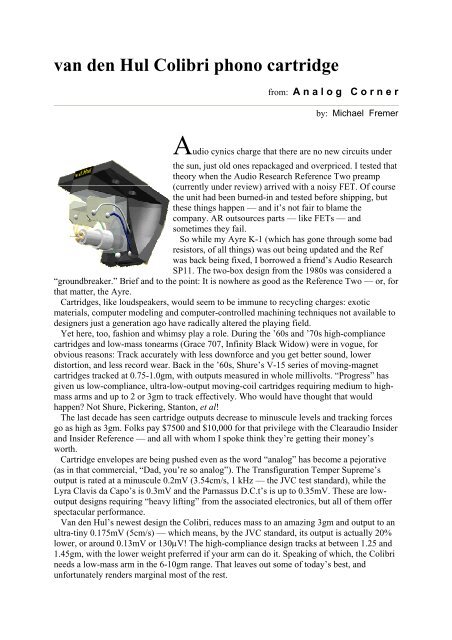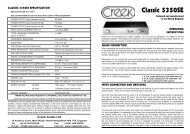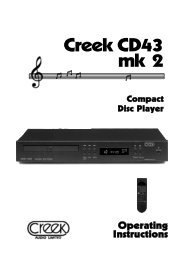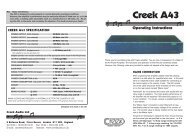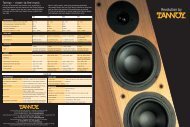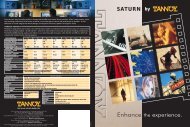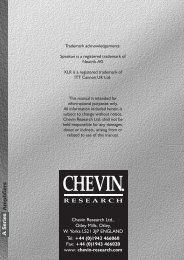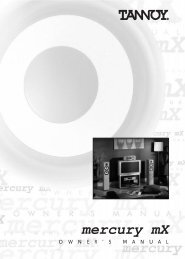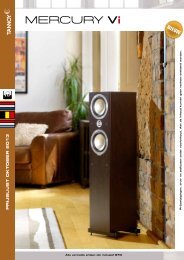van den Hul Colibri phono cartridge
van den Hul Colibri phono cartridge
van den Hul Colibri phono cartridge
You also want an ePaper? Increase the reach of your titles
YUMPU automatically turns print PDFs into web optimized ePapers that Google loves.
<strong>van</strong> <strong>den</strong> <strong>Hul</strong> <strong>Colibri</strong> <strong>phono</strong> <strong>cartridge</strong><br />
from: A n a l o g C o r n e r<br />
by: Michael Fremer<br />
Audio cynics charge that there are no new circuits under<br />
the sun, just old ones repackaged and overpriced. I tested that<br />
theory when the Audio Research Reference Two preamp<br />
(currently under review) arrived with a noisy FET. Of course<br />
the unit had been burned-in and tested before shipping, but<br />
these things happen — and it’s not fair to blame the<br />
company. AR outsources parts — like FETs — and<br />
sometimes they fail.<br />
So while my Ayre K-1 (which has gone through some bad<br />
resistors, of all things) was out being updated and the Ref<br />
was back being fixed, I borrowed a friend’s Audio Research<br />
SP11. The two-box design from the 1980s was considered a<br />
“groundbreaker.” Brief and to the point: It is nowhere as good as the Reference Two — or, for<br />
that matter, the Ayre.<br />
Cartridges, like loudspeakers, would seem to be immune to recycling charges: exotic<br />
materials, computer modeling and computer-controlled machining techniques not available to<br />
designers just a generation ago have radically altered the playing field.<br />
Yet here, too, fashion and whimsy play a role. During the ’60s and ’70s high-compliance<br />
<strong>cartridge</strong>s and low-mass tonearms (Grace 707, Infinity Black Widow) were in vogue, for<br />
obvious reasons: Track accurately with less downforce and you get better sound, lower<br />
distortion, and less record wear. Back in the ’60s, Shure’s V-15 series of moving-magnet<br />
<strong>cartridge</strong>s tracked at 0.75-1.0gm, with outputs measured in whole millivolts. “Progress” has<br />
given us low-compliance, ultra-low-output moving-coil <strong>cartridge</strong>s requiring medium to highmass<br />
arms and up to 2 or 3gm to track effectively. Who would have thought that would<br />
happen? Not Shure, Pickering, Stanton, et al!<br />
The last decade has seen <strong>cartridge</strong> outputs decrease to minuscule levels and tracking forces<br />
go as high as 3gm. Folks pay $7500 and $10,000 for that privilege with the Clearaudio Insider<br />
and Insider Reference — and all with whom I spoke think they’re getting their money’s<br />
worth.<br />
Cartridge envelopes are being pushed even as the word “analog” has become a pejorative<br />
(as in that commercial, “Dad, you’re so analog”). The Transfiguration Temper Supreme’s<br />
output is rated at a minuscule 0.2mV (3.54cm/s, 1 kHz — the JVC test standard), while the<br />
Lyra Clavis da Capo’s is 0.3mV and the Parnassus D.C.t’s is up to 0.35mV. These are lowoutput<br />
designs requiring “heavy lifting” from the associated electronics, but all of them offer<br />
spectacular performance.<br />
Van <strong>den</strong> <strong>Hul</strong>’s newest design the <strong>Colibri</strong>, reduces mass to an amazing 3gm and output to an<br />
ultra-tiny 0.175mV (5cm/s) — which means, by the JVC standard, its output is actually 20%<br />
lower, or around 0.13mV or 130µV! The high-compliance design tracks at between 1.25 and<br />
1.45gm, with the lower weight preferred if your arm can do it. Speaking of which, the <strong>Colibri</strong><br />
needs a low-mass arm in the 6-10gm range. That leaves out some of today’s best, and<br />
unfortunately renders marginal most of the rest.
Remark: The <strong>Colibri</strong> is currently available in a number of versions with different output and system weight.<br />
Latter also enables the use of heavier tonearms. For more details about all available versions please refer to our<br />
product information about The COLIBRI. —A.J. <strong>van</strong> <strong>den</strong> <strong>Hul</strong> B.V.<br />
A cactus needle would probably sound great attached to the Rockport turntable, so I also<br />
auditioned the lightweight, high-performance, $6000 <strong>Colibri</strong> (click here for current price) on the<br />
Immedia/Simon Yorke arm/’table combination, where it performed equally well, though of<br />
course the results were not quite as impressive as with the Rockport ’table. The only modern<br />
arm I can think of that’s optimized for such a lightweight, high-compliance <strong>cartridge</strong> is the<br />
Mörch, which I didn’t have on hand. 1 But based on how the Immedia handled the <strong>Colibri</strong>, I’d<br />
say the Graham would be equally viable. Another big hurdle would be the preamp gain. The<br />
Audio Research Reference was up to the task, offering sufficient low-noise gain to present<br />
quiet passages against an ink-black background.<br />
1: J-10 hears Judy Spotheim of La Luce/SpJ fame is getting fabulous sound out of a <strong>Colibri</strong>, special arm weights<br />
to suit.<br />
It’s scary mounting such a vulnerable design. Stylus guard? Yeah, right. Attached to what?<br />
There’s almost nothing to it: just a tube containing the cantilever/stylus assembly, coil/former,<br />
and ring magnet structure. That last is very small, hence the ultra-low output. The patented 1S<br />
stylus assembly with boron cantilever is also used in vdH’s Grasshopper, Black Beauty and<br />
Frog <strong>cartridge</strong>s, though a somewhat higher-grade diamond is used here. The 2µm by 85µm<br />
radius stylus is shaped like a “gar<strong>den</strong> spade,” according to the American importer. Its tall<br />
profile, coupled with the high compliance, is said to offer superb tracking.<br />
If you don’t lock this baby in, forget it. Proper VTA is critical to getting top-end sweetness,<br />
and even then, “sweet” would be an overstatement for this <strong>cartridge</strong>’s finest performance.<br />
“Sweet” and “lush” are not the <strong>Colibri</strong>’s fortés. Speed and detail are — top to bottom. In<br />
gar<strong>den</strong> spades! The <strong>Colibri</strong> isn’t the Cadillac of <strong>cartridge</strong>s; it’s the Lamborghini.<br />
Shed the weight, cast off the resonating body, and you end up with a <strong>cartridge</strong> with<br />
incredible resolution and superb transient performance. My friend Frank Doris once wrote of<br />
counting the rivets on a cymbal, and with this <strong>cartridge</strong> I know what he means. It’s a drum<br />
kit’s best friend, able to distinguish and communicate the tonal and textural character of<br />
cymbals better than any other <strong>cartridge</strong> I’ve heard, and equally adept at conveying their<br />
metallic solidity. Mere “speed” can’t do that. And it does so without adding brightness or<br />
sheen.<br />
The <strong>Colibri</strong> is equally adept on the bottom, offering impressive, overhang-free extension,<br />
explosive bass transients and dynamics, and superb control and solidity. Walloping kick<br />
drums, weighty toms, snappy snares, chiming, ringing splash cymbals, “cushy” rides — the<br />
<strong>Colibri</strong> delivers a drum kit any rock or jazz fan will melt hearing. As I write this I’m listening<br />
to Steely Dan’s “Kid Charlemagne,” from Royal Scam, and the profusion of colors from the<br />
drum kit alone is amazing.<br />
The <strong>Colibri</strong> delivers the transient goods without spotlighting, and without adding grain or<br />
sibilant edge. In fact, vocal sibilants — t, s and f — are downright delicate and refined.<br />
Upper-octave clarity, definition, and detail are delivered with smooth assurance. The<br />
<strong>cartridge</strong>’s handling of the guiro (a ribbed gourd rubbed with a stick) on David Bowie’s “The<br />
Man Who Sold the World” regularly dropped jaws when I played it for friends who thought<br />
they knew the track. And the <strong>Colibri</strong>’s portrayal of the mixed-in-the-background drum kit was<br />
equally amazing and impressive.<br />
Plucked and strummed transients like guitar strings were also well served by the <strong>Colibri</strong>. Its<br />
performance on the 45rpm 12" of Pete Townshend and Ronnie Lane’s string-drenched<br />
masterpiece “Street in the City” was positively awe-inspiring. PS Audio’s Paul McGowan<br />
was down delivering a power plant 300. I played that track for him and the audio veteran was
visibly moved, remarking that the midrange was really “happening.”<br />
While the <strong>Colibri</strong> exhibited a host of strengths, the other area in which it truly excelled was<br />
soundstaging. The extra detail it brought forth was placed in three-dimensional space in an<br />
impressively orderly fashion. When you hear an event you didn’t know was there, placed so<br />
clearly and so startingly defined in space, you just have to sit there and shake your head. A<br />
few days with the <strong>Colibri</strong> and I had a headache from all the shaking. Its total freedom from<br />
congestion, even when a host of events occurred in the same narrow upper-frequency band,<br />
was mighty impressive.<br />
I could go on about the <strong>Colibri</strong>’s spectacular performance, but you get the picture. It’s fast<br />
and detailed without being edgy and bright. It can sound aggressive and a bit tizzy right at the<br />
top if you don’t have the VTA and VTF precisely dialed in, but even then it will never sound<br />
coarse or harsh in overall character. And most important, it does not emphasize or spotlight<br />
record noise.<br />
First-rate dynamics, a neutral, open midband, superb top and bottom extension and control,<br />
and seat-of-the-pants drive and focus help make the <strong>Colibri</strong> an amazing performer. For $6000<br />
(click here for current price), it damn well better be! After reading about Frogs and Grasshoppers<br />
for years, the <strong>Colibri</strong> is the first “top-shelf” <strong>van</strong> <strong>den</strong> <strong>Hul</strong> I’ve had in my system. Now I know<br />
why guys like J-10 have been raving.<br />
But remember, it’s not for lovers of warm and lush. And to shine, it requires a low-mass<br />
arm (though one of moderate to medium mass will work), careful attention to setup, and a<br />
high-gain, low noise <strong>phono</strong> section. And because it uses a shorter cantilever than some earlier<br />
<strong>van</strong> <strong>den</strong> <strong>Hul</strong>s, it’s a low-rider with very tight record clearance.<br />
Stereophile, August 2000


